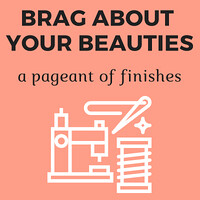I don’t spend much time considering the batting I’ll use for my projects. I buy Warm and White by the bolt—I think it’s good quality for the price—so that’s my go-to batting. Occasionally, when I’m having something longarmed, I’ll request Hobbs 80/20, but I sew with a lot of white backgrounds and I prefer the results with Warm and White. (In fact, there was one project that I lamented using the ecru-colored Hobbs product. Read about that quilt here.)
Quilting an ombré version of my Ridiculously Easy Jelly Roll Quilt made me reconsider my stance on batting. This version, which may be the darkest-colored quilt I’ve ever made (such that my husband dubbed it Night Mode), was kind of a mess. I used Warm and White and spray baste in my quilt sandwich. What resulted was lint everywhere—not bearding or pilling, just a linty mess. Before Night Mode was displayed at Garden of Quilts in 2022, I washed it repeatedly (I did not machine-dry it) and went over it again and again with a lint roller.
After this experience, I did some reading and talked to other quilters. The consensus seems to be that black batting can make saturated colors more vivid and that you can use black batting even if your quilt top contains some lighter fabrics. Most people thought using black batting with Night Mode would have curtailed the issues I experienced, and many told me the deciding factor of white versus black batting was the fabric’s quality, not its color. These black-batting adherents assured me that high-quality fabric would not look dingy or shadowed by black batting.
When it came time to get my Nantucket throw quilted for the recent Villa Rosa blog hop, I knew it was time to give black batting a try, so I bought a package of Quilters Dream Black Batting, and I really love the results. Now, this project was quilted by a longarmer, so there was no sticky spray baste to contend with. One way or another, the result is beautiful: The reds and blue are bold and bright, and the black doesn’t diminish the brilliance of the white, light blue, and peach present in the quilt top.
In short, I’ll use black batting again. I will steer clear of it in projects with light-colored wovens—that is, fabrics with not-so-tight weaves. And I probably won’t use it with Art Gallery Fabrics. AG produces beautiful fabric with a high thread count, but it’s the brand that got me in trouble with Hobbs 80/20, mentioned earlier.
Do you use black batting? If you have any insight into when you use it and when you don’t, please share your thoughts with us in the comments. Thanks!
Follow Me On ...
The pageant rules are simple:
- Post your finish in the linky tool. (No links to your own giveaway or linky, please!)
- Point your readers back here with a text link or use the button above.
- Visit and comment on other participants’ finishes.







Ha! I didn’t even know black batting existed.
ReplyDeleteMichelle
https://mybijoulifeonline.com
I've only used Hobbs 80/20 black with excellent results every time, and that's with black batik background and all colours of the rainbow batiks within the quilts! I also am a Warm and Natural/and White user and lover.
ReplyDeleteI haven't used black batting before. I have very few occasions to use it since most of my quilts have lighter neutrals in them rather than darker fabrics. Thanks for your insight. Blessings!
ReplyDeleteI keep meaning to give black batting a try myself. Thanks for the nudge!
ReplyDeleteHi Michelle, I used black batting for my son's Version 2.0 quilt. It had mostly dark fabrics and I just didn't want to take the chance of having little white batting sticking out. The fabrics that I used though were all Kona solids. The quilting came out great but since I didn't use white batting on it, I'm not sure if it would have been ok. I'm sure not going to remake it to find out! lol I would definitely use it again.
ReplyDeleteThanks for the information and the linking party.
I have black batting lying around because I wanted to give it a try. I heard it also works well with light background because it should minimize the visiblility of seam allowances. But I haven't gotten to the project I wanted to test it with ;)
ReplyDeleteYes I have been considering black batting for an upcoming quilt I want to do with a dark background. I think it would really make a difference.
ReplyDeleteUs quilters can always learn lessons, can't we? I have never used black batting, but then I can't remember the last time I made a dark quilt. Still, I would use it if the quilt top warranted it. Interestingly, our recent (last weekend) quilt show resulted in me hearing from several quilters who were scribes for the four certified judges used to judge 500 quilts, that several judges commented on the importance of using black batting. Apparently they saw instances where black would have been more appropriate than white or cream. Those quilter-scribes learned a lesson simply by volunteering as they did.
ReplyDelete